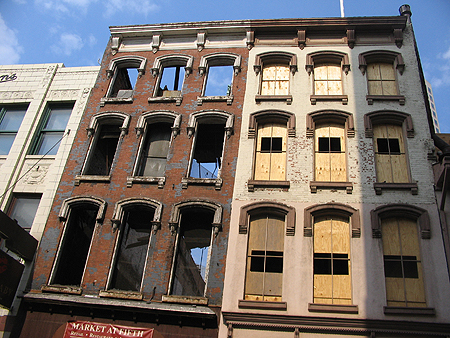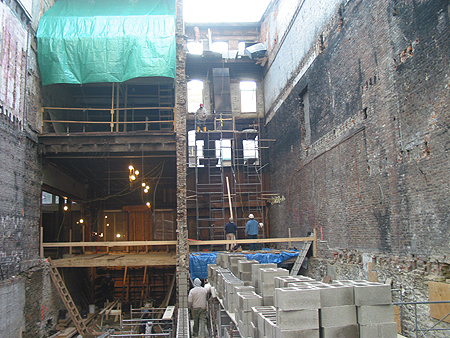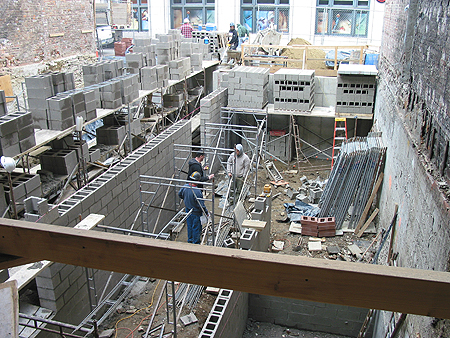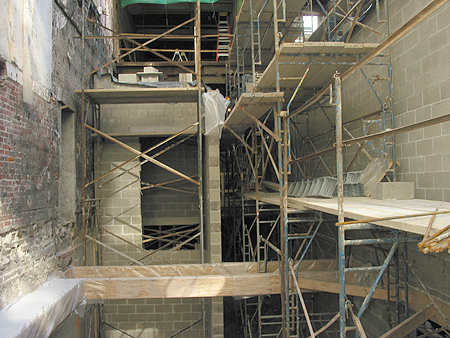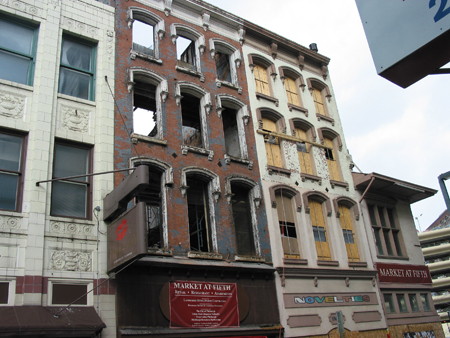
Category Archive: Neighborhood Development
-
Aeberlie Property Restoration Proceeds
PHLF News
March 7, 2008Last year officials of Allegheny General Hospital, which owns the Aeberlie house on North Avenue next to the hospital, asked us for assistance to find a way to restore and reuse this handsome Victorian building that has been decaying for many years.
PHLF underwrote the costs for Landmarks Design Associates Architects to prepare an initial study and the hospital then hired the firm to proceed with a detailed plan to stabilize the building, make it water tight and restore the exterior.
A grant from the Richard King Mellon Foundation and other funding enabled the hospital to proceed with the work which will greatly improve this important buildings across from the area of the Allegheny Commons that is being restored.
-
Market at Fifth Continues
PHLF News
March 7, 2008Construction is proceeding with our three buildings at the gateway to Market Square at Market and Fifth Avenues downtown.
We acquired these buildings from URA, severely deteriorated, and have dismantled much of the wall structures brick-by-brick, cleaning the bricks to return them to rebuild the walls.
Our timetable calls for completion early next winter. Seven apartments will be on the second and third floors consisting of 6 one bedrooms and 1 two bedroom, two with roof gardens.
Substantial contributions are needed to complete this work, resulting in a Platinum level Green certified historic complex.
Costs will exceed $3,500,000, but we feel the expense is worth it to preserve and restore these anchor corner properties across from the forthcoming new PNC Park, and within view of Heinz Hall, and helping to frame the entranceway to Market Square.
-
Worrisome in Manchester
PHLF News
March 7, 2008City of Pittsburgh’s Department of Building Inspection continues to list deteriorated, but architecturally valuable houses in Manchester for demolition.
If these houses are lost, the magic of historic Manchester will be forfeited and can never be recovered. It is the architectural continuity of Manchester that makes it such an attractive place to live.
We are working with the City and the Manchester Citizens Corporation to try to develop ways to keep these buildings, and we seek new owners for them.
Cost of acquisitions are low; call Tom Hardy at Manchester Citizens Corporation: 412/323-1743.
-
PHLF Introduces Grocer to Hill District
PHLF News
March 7, 2008For nearly a quarter a century, the residents of the Hill District have sought to attract a quality full service grocer to the Hill.
When Dr. Howard B. Slaughter, Jr. became Chief Executive Officer of Landmarks Community Capital Corporation (LCCC) a subsidiary of Pittsburgh History & Landmarks Foundation (PHLF) in October 2007, he made it a top priority to locate a suitable grocer interested in locating in the Hill District.
PHLF worked with Save-A-Lot in locating a new store in Wilkinsburg and experienced excellent cooperation with their design and graphics.
After a series of meetings to engage Save-A-Lot’s interest in the Hill District, LCCC hosted a breakfast meeting to introduce Save-A-Lot to the community and City officials.
The next step is to have a meeting in the Hill District to discuss the possibility and viability of this grocer locating in the Hill District, which is scheduled for April 12th. Stay tuned…
Save-A-Lot has provided the community two videos for viewing by clicking here.
-
Selling Pittsburgh’s Strip District
By Tony LaRussa
TRIBUNE-REVIEW
Friday, February 29, 2008Buzz up!
The deal is off.
The city is bagging plans to turn the produce terminal on Smallman Street in the Strip District into a trendy marketplace.
The Urban Redevelopment Authority, which owns the 140,000-square-foot Pennsylvania Railroad Fruit Auction & Sales Building, signed five-year leases with the tenants last month, leaving just 6 percent of the building unoccupied.
“There’s been a change in thinking away from creating a market house under a single roof to a concept in which the entire Strip is viewed as the city’s market district,” said Rob Stephany, URA deputy executive director. “Ultimately, we want to create a really vibrant retail environment along Smallman and the sides streets that connect with Penn Avenue.
“We see the (produce) terminal building as just one part of the market district.”
Community development group Neighbors in the Strip proposed using $8 million in state and local grants to transform the terminal into a marketplace.The URA is open to leasing the available 8,000 square feet in the building — or space on the outside platform and along Smallman — to vendors, Stephany said. The URA will work with Neighbors in the Strip to devise plans to advance the market district concept, he said.
Becky Rodgers, executive director of Neighbors in the Strip, said advancing the market district concept will require her organization to focus on projects such as:
• Attracting more residential development
• Branding and marketing the neighborhood as Pittsburgh’s market district
• Helping property owners develop under-utilized second and third floors
• Making Smallman Street safer for pedestrians
• Erecting signs listing the type and location of Strip businesses
• Helping property owners develop “mini-market houses” in buildings that might be too large for a single business.
“Our goal is to promote economic development while preserving the historic character of the Strip,” Rodgers said. “The traditional grittiness is something that stakeholders have said they want preserved.”
Brad Kokowski, who’s owned Superior Produce in the terminal building for 20 years, likes the idea of attracting shoppers from the busy Penn Avenue corridor.
“Right now, there aren’t a lot of reasons for people to come over here,” said Kokowski, whose business is a combination of wholesale and retail. “If it’s done right, this terminal and the area around it could make a great market. I just don’t want to see businesses like mine, which have been here for a long time, pushed out for it to happen.”
Sam Patti, who owns La Prima Espresso Co. in the terminal, thinks the Strip could benefit from using the building’s empty space for more retail, wholesale or a combination of the two — as long as its basic character is not changed.
“The space needs to be clean and secure, but it doesn’t need to be anything fancy,” he said. “This is the Strip. People like the gritty atmosphere. If they want glitzy, there’s plenty of other places around for them to shop.”
Tony LaRussa can be reached at tlarussa@tribweb.com or 412-320-7987.
-
South Vo-Tech sold to become housing
Old South High site closed in 2004
Friday, February 29, 2008
By Eleanor Chute
Pittsburgh Post-GazetteThe now-empty South Vo-Tech High School, built in 1897, will have a new life as an upscale residence.
The Pittsburgh Public Schools board Wednesday approved selling the high school building, originally known as South High School, to lone bidder Gregory Development for $1.1 million. The district had set a minimum bid of $500,000.
The sale includes the original building and addition, which are bounded by Carson, 10th, Sarah and Ninth streets, but it does not include the annex located across 10th street, behind a gas station. The school has been closed since 2004, but the annex is in use.
Gregory Coyle, president of Gregory Development & Management Inc., said, “It’s going to be a high-end residential project. It will be probably 75 units, in that range.”
Whether it will be condominiums or rental units will depend on the market down the road, he said.
“I’m very excited about the prospect of developing it. I think the historical aspect is something we’re going to work very hard to maintain,” he said.
Kevin Hanley, manager of real estate and housing programs for the nonprofit South Side Local Development Co., which is not involved in the project, called the building “a gateway to the neighborhood.”
“It’s a key parcel, based on historical and architectural significance and location,” he said.
Mr. Hanley said Gregory Development previously has done some “solid work” on the South Side.
Mr. Coyle said the approval process could take up to 12 months, and construction could take another 12 months.
Mr. Coyle, who lives on the South Side, said the project is not intended for student housing, which some South Side residents had opposed.
The building was purchased as is, so the developer has to pay for the necessary environmental remediation, estimated at $700,000.
Other Gregory developments on the South Side include 1205-1213 E. Carson St. and 2026 E. Carson St.
Mr. Coyle also is a partner in ASC Development, which has been involved in projects such as a Wal-Mart-anchored shopping centers in Ebensburg, Edinboro, Bradford, Delmont and Shippensburg as well as one in Kilbuck, which was canceled after the planned site was plagued by landslides.
The school board also approved a resolution authorizing the chief operations officer and the solicitor to “expeditiously move forward with the disposal” of 20 closed buildings, for which the ongoing maintenance costs exceed a total of $1 million.
If a building fails to sell “in their initial attempt,” then the two are authorized to find a “responsible entity, within the immediate community of the school,” which could receive the building at a nominal cost.
The 20 buildings are Beltzhoover, Boggs, Burgwin, Chatham, Columbus, Connelley, East Hills, Gladstone, Knoxville, Lemington, Letsche, Madison, Mann, Miller, Morningside, Prospect, Rogers (in 2009), Vann, Washington and West Side.
Education writer Eleanor Chute can be reached at echute@post-gazette.com or 412-263-1955.
First published on February 29, 2008 at 12:00 am -
Black leaders seek delay in Schenley decision
By Bill Zlatos
TRIBUNE-REVIEW
Wednesday, February 27, 2008A group of black community leaders is urging the city school board tonight to postpone or vote against a proposal to move students from Schenley High School in Oakland.
In a letter dated today to board members, the Black Political Empowerment Project or B-PEP urged the board to reconsider Superintendent Mark Roosevelt’s proposed closing of Schenley. Roosevelt wants to close the school because of the estimated $64.3 million cost of removing asbestos and upgrading the building.
Under Roosevelt’s plan, to be voted on today, the district would close Schenley and move students this fall while it decides whether to shut the school down permanently or renovate it. As a result, the board is considering the following actions:
* Relocating Schenley students who would be in grades 10 through 12 to now-closed Reizenstein in East Liberty; * Shifting 174 students in the robotics technology program at Schenley to Peabody High School in East Liberty: and * Sending ninth graders who live in Schenley’s feeder pattern to a proposed University Prep School at Milliones in the Hill District.
B-PEP Chairman Tim Stevens recommended hold off on moving the Schenley students until the district develops a comprehensive approach to meeting the needs of the nine high schools that did not meet federal academic standards.
Bill Zlatos can be reached at bzlatos@tribweb.com or 412-320-7828.
-
North Side groups at odds over former bank’s historic status
Wednesday, February 27, 2008
By Mark Belko,
Pittsburgh Post-GazetteThe city planning commission will leave it up to City Council to decide whether a North Side building linked to prominent Chicago architect D.H. Burnham will be preserved or perhaps face the wrecking ball.
In a 3-1 vote with one abstention, the commission decided to take no action on the proposed nomination of the former Workingmen’s Savings Bank on East Ohio Street as a city historic structure after North Side groups and residents offered mixed views of the designation, with some favoring it and some opposed.
A Lawrenceville company, Bentley Commercial, recently purchased the vacant Beaux Arts-style building with the intent to redevelop it. At one point, Bentley stated it had plans to demolish the structure, triggering the nomination to preserve it.
Since then, some North Side neighborhood groups have been working with the developer to try to devise a plan that would preserve the building, built in 1902, while allowing development to proceed.
Some fear the designation, which would protect the building from demolition, could interfere with development.
Pam Minton, vice president of the Deutschtown New Hope Council, said restoration could be extremely expensive. With a historic designation, “I know what will happen, it will just sit there,” she said.
But those who supported the designation said there could be tax credits and other incentives for historic renovation that could lower Bentley’s costs.
Rather than making a recommendation, the commission decided to take no action, meaning it automatically goes to City Council, which will have 90 days to act on the nomination.
In a separate action, the commission did recommend a historic designation for a Homewood house at 7101 Apple St. that once served as headquarters of the National Negro Opera Company.
Mark Belko can be reached at mbelko@post-gazette.com or 412-263-1262.
First published on February 27, 2008 at 12:00 am

